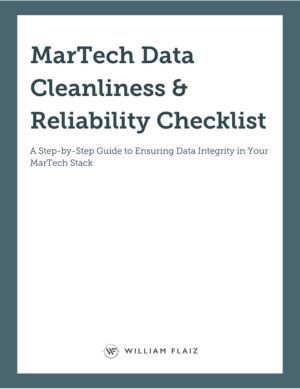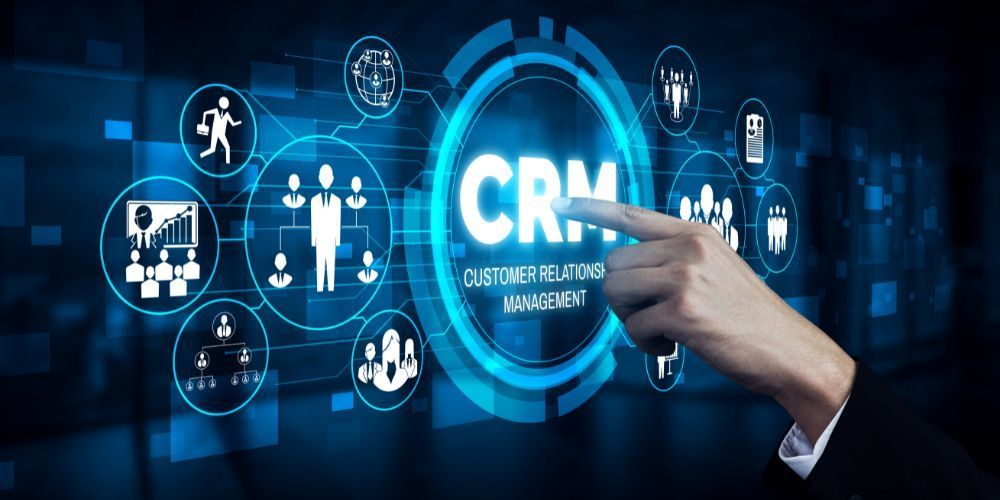MarTech Failure Isn't About Technology: The Critical Role of Data Quality
In my years leading digital transformation initiatives across various organizations, I've witnessed a recurring scene: a company invests hundreds of thousands—sometimes millions—of dollars in cutting-edge marketing technology, only to find themselves frustrated months later when the promised results fail to materialize. The executive team grows restless, marketing leaders become defensive, and eventually, fingers point toward the technology itself. "This platform isn't delivering what the vendor promised," they conclude.
But having overseen numerous MarTech implementations, I've discovered a fundamental truth: technology rarely fails on its own. Instead, what undermines these sophisticated systems is something far more basic yet frequently overlooked—the quality of the data flowing through them.

The MarTech Paradox
The marketing technology landscape has exploded over the past decade. Scott Brinker's famous MarTech landscape featured just 150 solutions in 2011. By 2022, that number had ballooned to over 8,000 platforms. Global spending on marketing technology now exceeds $120 billion annually, reflecting organizations' growing belief that the right technology stack is the key to marketing success.
Yet paradoxically, as MarTech investments have increased, many companies report diminishing returns. A recent study by Gartner found that marketing leaders utilize only 58% of their MarTech stack's potential, despite the substantial resources dedicated to these tools. Another report from Forrester revealed that 21% of marketers believe their MarTech investments have actually contributed to greater complexity rather than solving problems.
This contradiction illuminates what I call the "MarTech Paradox": the more organizations focus on acquiring sophisticated technology without addressing fundamental data issues, the less value they extract from their investments.
Before approving new MarTech purchases, implement a mandatory "data readiness assessment" that evaluates whether your organization has the quality data needed to fully leverage the technology's capabilities. Make this assessment part of your formal procurement process.
Understanding the True Cost of Poor Data Quality
When we discuss "poor data quality" in marketing, we're talking about information that is inaccurate, incomplete, inconsistent, or outdated. The impact of these issues extends far beyond mere technical inconvenience—it directly affects business outcomes.
IBM estimates that poor data quality costs U.S. businesses over $3.1 trillion annually. Within marketing specifically, the consequences manifest in numerous ways:
- Wasted Marketing Spend: Campaigns targeting incorrect segments or using faulty personalization waste budget on messaging that never reaches its intended audience.
- Lost Revenue Opportunities: Missing or outdated information means missed chances to engage customers at critical moments in their journey.
- Damaged Customer Relationships: Nothing frustrates customers more than receiving irrelevant messages or being asked repeatedly for information they've already provided.
- Flawed Decision Making: When analytics draw from compromised data, the resulting insights and strategic decisions become unreliable.
The principle of "garbage in, garbage out" applies perfectly to marketing automation. Even the most sophisticated algorithm can't compensate for fundamentally flawed input data. Your AI-powered personalization engine, predictive analytics models, and customer journey orchestration tools—all depend entirely on the quality of data they process.
Conduct a quarterly "data waste audit" that tracks and quantifies marketing dollars spent on campaigns targeting inaccurate or outdated segments. Calculate this "data waste percentage" and set progressive reduction targets. This creates a tangible financial metric that executives can understand and support.
Common Data Quality Issues in Marketing
Through my work consolidating complex digital ecosystems and implementing marketing automation systems, I've identified several data quality issues that consistently undermine marketing effectiveness:
Incomplete or Outdated Customer Information
This is perhaps the most prevalent issue. Customer records missing crucial fields like email addresses, product preferences, or demographic information severely limit segmentation and personalization capabilities. Similarly, outdated information creates a false picture of your customer's current needs and circumstances.
Implement a "completeness score" for each customer record, weighing fields based on their marketing value. Target your highest-value customers with progressive profiling campaigns to improve completion rates for these critical segments first, where improved data will deliver the greatest ROI.
Duplicate Records and Fragmented Customer Views
When the same customer exists multiple times in your database (often with slight variations in name spelling or contact information), your system fails to recognize them as a single entity. This results in fragmented customer views, conflicting engagement records, and often, contradictory marketing messages reaching the same person.
Deploy a systematic deduplication process using fuzzy matching algorithms that go beyond exact match criteria. Start with a pilot on a subset of your database (10,000 records) to quantify duplication rates and potential impact before scaling to your full database. Set a recurrent schedule (monthly for active segments, quarterly for the full database) to catch new duplicates before they proliferate.
Inconsistent Formatting and Data Structure
Even simple inconsistencies—such as storing phone numbers in different formats or using various conventions for address information—can prevent systems from properly processing and connecting related data points. These structural inconsistencies become particularly problematic when attempting to activate data across multiple platforms.
Create a standardized data dictionary that defines proper formats for all customer data fields. Then implement validation rules at every data entry point to enforce these standards. For existing data, use batch normalization scripts to bring historical records into compliance with your new standards.
Data Silos Across Departments and Platforms
When customer information remains trapped in disconnected systems—sales data in the CRM, behavioral data in the marketing automation platform, service history in the support system—marketing teams operate with incomplete visibility. These organizational and technological silos prevent the development of comprehensive customer understanding.
Map your customer data ecosystem by creating a visual flowchart showing where customer data originates, where it's stored, and how it moves between systems. Identify the highest-impact integration points where connecting silos would create the most marketing value. Prioritize these connections in your data integration roadmap.
Download the Free MarTech Data Cleanliness & Reliability Checklist
Did you know? 25% of marketing data is inaccurate. Don’t let bad data ruin your campaigns. Get the MarTech Data Cleanliness Checklist today!
Signs Your Data Quality Is Undermining Your MarTech
How can you tell if data quality issues are sabotaging your marketing technology investments? Watch for these warning signs:
- Unexplainable Campaign Performance: When similar campaigns produce wildly different results without clear reasons, data quality issues may be creating invisible variables.
- Low Engagement Rates: Consistently poor open, click, and conversion rates often indicate targeting or personalization problems stemming from inaccurate data.
- Customer Complaints About Relevance: If customers regularly report receiving irrelevant offers or duplicate messages, your customer data likely contains significant errors.
- Difficulty Measuring ROI: When you struggle to connect marketing activities to outcomes, fragmented or incomplete data may be preventing accurate attribution.
- Manual Workarounds Become the Norm: If your team constantly exports data, manipulates it in spreadsheets, and re-imports it into systems, you're compensating for fundamental data quality issues.
To assess your organization's data health, ask yourself these questions:
- Can we quickly identify our most valuable customers across all channels and touchpoints?
- Do we trust our segmentation data enough to make significant budget decisions based on it?
- How many fields in our customer database contain standardized, validated information versus free-form entries?
- Can we trace a customer's complete journey from first touch to purchase without gaps?
- How frequently do we audit and cleanse our marketing databases?
Create a "data quality dashboard" with 5-7 key metrics that provide visibility into your data health. Include metrics like duplicate rate, field completion percentage, data recency scores, integration success rates, and data usage metrics. Review this dashboard monthly with your marketing leadership team to drive accountability and improvement.
Building a Foundation for Data Quality
Improving marketing data quality isn't a one-time project but an ongoing commitment. Here's how to build a sustainable foundation:
Establish Data Governance Practices
Data governance defines the rules, responsibilities, and processes for ensuring data quality throughout its lifecycle. Start by:
- Designating clear ownership for different data domains
- Creating standards for data entry, formatting, and validation
- Developing policies for data access, usage, and retention
- Establishing regular audit procedures to maintain quality
The most successful governance programs balance rigor with practicality—strict enough to ensure quality but flexible enough to adapt to marketing's dynamic needs.
Form a cross-functional "Data Quality Task Force" with representatives from marketing, sales, IT, and customer service. Assign specific data domain ownership to each member and meet bi-weekly to address quality issues. Create a RACI matrix (Responsible, Accountable, Consulted, Informed) for key data processes to clarify roles and responsibilities.
Create a Data Quality Assessment Framework
You can't improve what you don't measure. A data quality assessment framework helps quantify the current state of your marketing data across dimensions like:
- Accuracy: Does the data reflect reality?
- Completeness: Are all necessary fields populated?
- Consistency: Is information uniform across systems?
- Timeliness: How current is the data?
- Relevance: Does the data support current marketing objectives?
Regular assessments using this framework will identify priority areas for improvement and track progress over time.
Implement a quarterly "data quality sampling" process where you manually verify the accuracy of 100 randomly selected customer records against external sources (such as LinkedIn profiles, company websites, or direct verification). Calculate an accuracy score and track improvement over time. This manual verification provides a reality check that automated assessments might miss.
Implement Data Cleansing and Enrichment Processes
Once you've identified issues, address them through systematic cleansing and enrichment:
- Use validation tools to correct formatting inconsistencies
- Deduplicate records using fuzzy matching algorithms
- Augment first-party data with reliable third-party sources
- Implement progressive profiling to gradually build more complete customer profiles
- Leverage AI-assisted tools to identify and resolve data anomalies
Remember that data cleansing isn't just about fixing existing problems—it's about establishing processes that prevent new issues from accumulating.
Start with a "high-value segment data rescue" project. Identify your most valuable customer segment (typically 10-20% of your database that drives 60-80% of revenue) and focus intensive cleansing and enrichment efforts on this group first. This targeted approach delivers quicker ROI than trying to fix everything at once and demonstrates the value of data quality initiatives.
Foster a Data-Quality-First Culture
Technical solutions alone won't solve data quality challenges. You need organizational alignment around the value of quality data. This means:
- Training teams on data quality principles and best practices
- Recognizing and rewarding behaviors that contribute to data integrity
- Including data quality metrics in performance assessments
- Promoting transparency about data limitations and ongoing improvement efforts
When marketing teams understand how data quality affects their ability to deliver results, they become natural advocates for better practices.
Develop a "Data Quality Champions" program that trains and empowers representatives from each marketing function. These champions serve as local experts, provide peer coaching, and advocate for quality practices within their teams. Recognize their contributions through formal acknowledgment and consider linking data quality improvements to performance bonuses.
Balancing Technology and Data Quality
The relationship between MarTech and data quality isn't an either/or proposition—it's about finding the right balance and sequence.
How to Approach MarTech Investments with Data Quality in Mind
Before adding new technology to your stack:
- Audit your existing data: Understand its strengths and limitations.
- Define your data strategy: Clarify what information you need to achieve your marketing objectives.
- Evaluate vendors on data capabilities: Assess how well each solution handles data validation, cleansing, and integration.
- Plan for data migration: Allocate sufficient resources to transfer, validate, and optimize data for the new system.
- Establish success metrics: Define how you'll measure improvements in both data quality and marketing outcomes.
This approach ensures that data considerations are central to technology decisions, not an afterthought.
Create a "MarTech Data Requirements Document" for each new platform you consider adopting. This document should specify the minimum data quality levels needed for success (e.g., "80% of customer records must have valid email addresses"), integration requirements, and data governance implications. Make vendor selection contingent on their ability to support these requirements.
The Role of CDPs in Improving Data Quality
Customer Data Platforms (CDPs) have emerged as a potential solution to marketing data challenges. By centralizing customer information from disparate sources, creating unified profiles, and enabling consistent activation across channels, CDPs can significantly improve data quality.
However, CDPs aren't magic bullets. They work best when implemented as part of a broader data strategy, with clean input data and clear use cases. A CDP built atop fragmented, inconsistent data will simply perpetuate existing problems more efficiently.
Actionable Tip: If implementing a CDP, start with a focused use case that delivers clear business value. For example, begin with unifying customer profiles across your top two marketing channels before attempting to integrate all data sources. This phased approach allows you to demonstrate value quickly while establishing the data quality protocols needed for broader implementation.
When to Invest in Tools vs. When to Focus on Cleaning Existing Data
Sometimes, the right decision is to pause technology acquisition and redirect resources toward improving your foundational data. Consider this approach when:
- Basic customer information is highly incomplete or inaccurate
- You struggle to measure the performance of existing tools due to data limitations
- Teams spend more time managing data workarounds than using technology for its intended purpose
In other cases, strategic technology investments can accelerate data quality improvements. Look for tools that:
- Automate data validation and standardization
- Provide robust data governance capabilities
- Offer pre-built integrations with your existing stack
- Include machine learning features that improve data quality over time
The key is making these decisions deliberately, with a clear understanding of your data reality.
Apply the "40/40/20 rule" to your MarTech budget: allocate 40% to technology, 40% to data quality initiatives, and 20% to training and adoption. This balanced investment approach ensures that your technology has the data foundation and user expertise needed to deliver results.

Data Quality's Impact on Emerging MarTech Trends
As marketing technology continues to evolve, data quality becomes even more critical. Here's how data quality will impact key emerging trends:
AI and Machine Learning in Marketing
The explosion of AI-powered marketing tools promises automated insights, predictive customer behavior modeling, and hyper-personalization at scale. However, these advanced capabilities depend entirely on quality training data.
AI systems amplify both the benefits of good data and the consequences of bad data. When trained on inaccurate, biased, or incomplete information, AI can generate systematically flawed outputs while projecting the illusion of precision. This creates a dangerous situation where marketers may place excessive trust in recommendations derived from fundamentally problematic data sources.
Before implementing AI-driven marketing tools, conduct an "AI data readiness assessment" that evaluates your data against specific requirements for machine learning applications. Focus particularly on data completeness, bias detection, and historical depth. Implement a "confidence score" system that communicates to users the reliability of AI-generated recommendations based on the quality of underlying data.
Privacy-First Marketing and First-Party Data Strategy
As third-party cookies disappear and privacy regulations tighten, organizations are pivoting toward first-party data strategies. This shift makes the quality of directly collected customer information more vital than ever.
When you can no longer rely on third-party data to fill gaps in customer profiles, your ability to capture, validate, and activate first-party data becomes a critical competitive advantage. Organizations with robust data quality processes will be better positioned to thrive in this privacy-centric environment.
Audit your data collection touchpoints to identify high-impact opportunities for gathering quality first-party data. Redesign these interactions to maximize both compliance and data value, using techniques like progressive profiling, preference centers, and value exchanges. Develop a "first-party data scorecard" that tracks both quantity and quality metrics for the customer information you're collecting.
Omnichannel Experience Orchestration
True omnichannel marketing—delivering seamless, consistent experiences across channels—depends on high-quality, unified customer data. Even minor data inconsistencies can create disjointed experiences that frustrate customers and undermine brand trust.
As customers increasingly expect personalized, contextually relevant interactions regardless of channel, the cost of poor data quality grows exponentially. Each data error can cascade across multiple touchpoints, creating compounding negative experiences.
Build a "customer data continuity test" program where you regularly conduct end-to-end experience audits across channels for a sample of customer profiles. This process helps identify where data fragmentation creates disconnected experiences from the customer's perspective. Prioritize fixing these cross-channel data gaps based on customer impact and frequency.
Real-Time Data Activation
The trend toward real-time marketing—responding to customer signals as they happen—leaves no margin for data quality issues. When decisions must be made in milliseconds, there's no time for manual data cleaning or validation.
Organizations that haven't established automated data quality processes will struggle to participate effectively in real-time marketing ecosystems. The speed of data activation makes proactive quality measures essential, as retrospective corrections come too late to salvage the customer experience.
Implement "data quality gates" in your real-time activation workflows that automatically evaluate incoming data against predefined quality thresholds. Create fallback logic that gracefully handles situations where data quality is insufficient for confident decision-making, rather than making potentially damaging automated decisions based on suspect information.
Composable MarTech Architecture
The shift toward composable, API-first marketing technology—where organizations assemble custom stacks from specialized components rather than adopting monolithic platforms—makes data quality and standardization even more crucial.
When data must flow seamlessly between dozens of integrated systems, consistent data structures and reliable quality become foundational requirements. Without them, the promised flexibility of composable architecture transforms into costly integration complexity.
Develop a centralized "data contract" system that defines standard data schemas, validation rules, and exchange protocols for all components in your marketing ecosystem. Require new MarTech vendors to demonstrate compatibility with these data contracts before integration. This approach ensures that composable systems share a common data language, reducing quality issues at integration points.
Data Before Technology
As marketers, we're naturally drawn to innovation—the latest platforms, the newest capabilities, the cutting-edge techniques. While this forward-looking mindset serves us well in many contexts, it can lead us astray when building our marketing technology infrastructure.
The most successful digital marketing leaders I've encountered share a common approach: they treat data as the foundation and technology as the enabler. They understand that even the most sophisticated MarTech stack is only as effective as the information flowing through it.
This perspective requires a fundamental shift in how we allocate resources and attention. Rather than asking, "Which tools should we buy next?" start by asking, "How can we ensure our customer data is accurate, complete, and actionable?" This reframing leads to more thoughtful technology decisions and, ultimately, better marketing outcomes.
In an increasingly competitive landscape, data quality has become a significant differentiator. Organizations that master their marketing data develop deeper customer insights, create more relevant experiences, and extract greater value from their technology investments.
Begin your data quality journey with a "Quick Win Data Project" that delivers tangible results within 30 days. For example, identify and merge duplicate profiles for your top 100 customers, or standardize name formats across your email subscriber list. Use these early successes to build momentum and demonstrate the value of investing in data quality before expanding to more complex initiatives.
Remember: Successful MarTech implementation isn't about having the most advanced technology—it's about having the right data to power it. As you navigate emerging trends and evolving customer expectations, making data quality a strategic priority will provide the foundation for sustainable marketing success.











